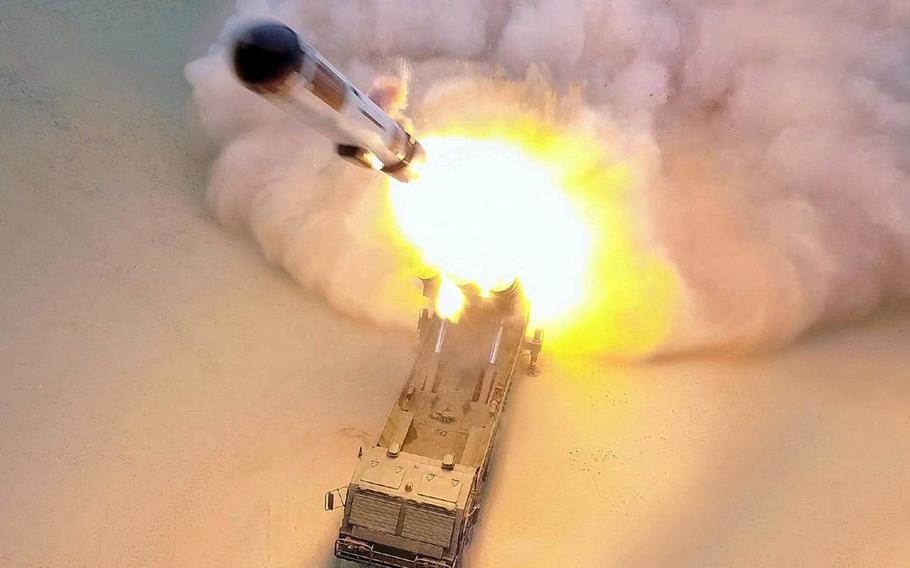
North Korea test-fires a ballistic missile off its eastern coast in this image released by the state-run Korean Central News Agency, Jan. 28, 2022. (KCNA)
The communist regime in North Korea is more threatening than ever. On June 5, Pyongyang launched eight short-range missiles, the most ever in a single day.
The next day, South Korea and the United States launched the same number of missiles. President Yoon Suk Yeol, inaugurated last month, promises a hardline approach to the North.
North Korea also just tested a missile capable of reaching the United States. The North has pursued nuclear weapons since 2006. From time to time, Pyongyang threatens to use them, including against the U.S, as well as Japan and South Korea.
These latest tests occur as the Biden administration gives priority to Northeast Asia defense. Last month, President Joe Biden visited both South Korea and Japan, with emphasis on military and Pacific security.
In moving forward, U.S. government officials should keep in mind three basic realities about dealing with North Korea. First, for many years Pyongyang has been inconsistent, often erratically. In 2013, the regime declared a “state of war” with South Korea and abruptly abrogated the 1953 armistice that ended the Korean War.
Yet, accommodating moves followed. In short, unpredictability is the norm. This implies considerable factional infighting at the top, along with collective insecurity.
Second, we must highlight commitment to defense of South Korea and our own readiness, and willingness, to use a range of forces. The Obama administration rightly deployed the THAAD (Terminal High Altitude Air Defense) anti-missile system for this purpose.
In 2013, the Pentagon expanded anti-ballistic missile defenses on the U.S. West Coast. Simultaneously, THAAD was sent to Guam, a potential target. In 2009, THAAD was deployed to Hawaii for the same reason.
On cue, China expressed indignation about anti-missile deployments. That was predictable, and understandable given potential use of the system’s radars for information gathering. At the same time, Beijing worked to restrain Pyongyang, including suspending airline flights between the two cities.
Third, we should emphasize coordination with other nations. This ideally should include China and Russia, but always our close friend South Korea and ally Japan.
South Korea’s substantial investment in and trade with China grows, while North Korea remains a costly dependent, though ideologically important. China’s President Xi Jinping visited Seoul in 2014. He finally visited North Korea in 2019.
China’s foreign policy reflects self-interest, and traditional caution regarding military force. North Korea is a drain, and over time a source of growing well-founded anxiety.
The COVID-19 pandemic has brought North Korea’s long-evident economic deterioration to a crisis point. Trade and wider interchange with China contracted. Long-term economic sanctions stymie recovery.
The brutal Korean War of 1950 to 1953 devastated the Korean Peninsula, and made the Cold War global. President Harry Truman’s courageous decision to support the United Nations in defending the South against invasion from the North laid the foundation for today’s remarkably successful Republic of Korea.
Throughout the long Vietnam War, South Korea maintained substantial military combat forces in South Vietnam in support of South Vietnamese and U.S. forces, as well as our other allies Australia and New Zealand.
Democratic change culminated with election in 1998 of President Kim Dae-jung, heroic opponent of dictatorship. In 2000, he received the Nobel Peace Prize. During the earlier dictatorship, Kim survived imprisonment and at least one attempt to kill him. Occasional political turmoil since 1998 confirms South Korean democracy.
U.S. leaders should emphasize collaboration with allies, underscore military commitment and encourage South Korean diplomatic leadership. The Biden administration is returning to traditional, very strong ties between the U.S. and our allies, including closer military cooperation.
Our powerful comprehensive alliance, established during the Korean War, greatly reinforced during the Vietnam War, is now unbreakable.
Arthur I. Cyr is author of “After the Cold War — American Foreign Policy, Europe and Asia.”